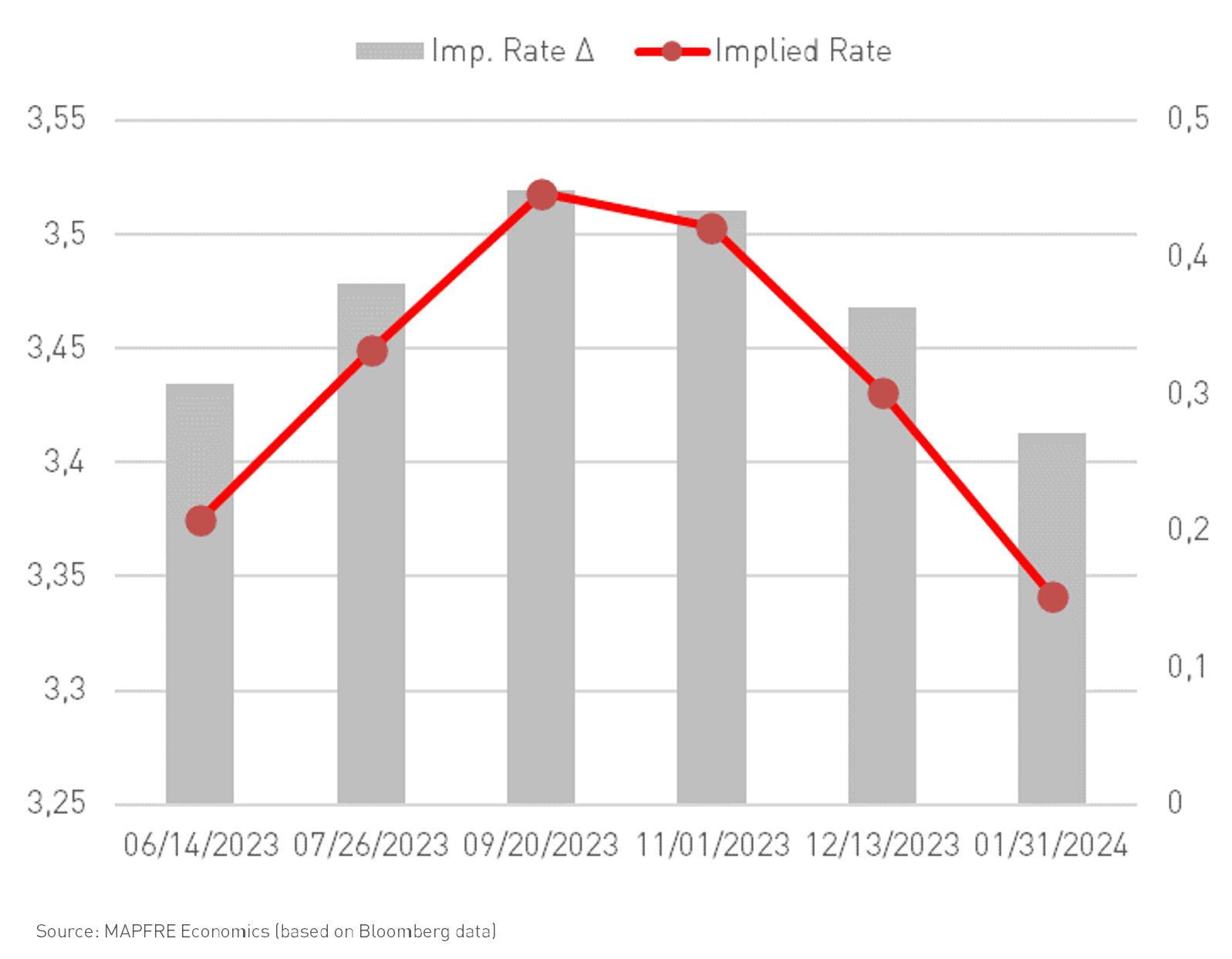Monetary Policy Update
Author: MAPFRE Economics
Federal Reserve
In its May meeting, the United States Federal Reserve unanimously decided to once again increase benchmark interest rates by 25 basis points (bps), placing them in the official range of 5.00-5.25%. By doing so, it opened the door to putting the tightening cycle on hold (currently on par with that of 2006-2007), though in the future it will be subject to new incoming inflation and economic performance data, and it has not committed to a terminal rate (see Chart 1). It should be noted that this narrow margin for maneuvering is maintained in response to cumulative tightening of monetary policy in the United States, the monetary policy’s delayed effects on economic activity and inflation, and recent economic and financial developments.
Chart 1
Benchmark interest rates
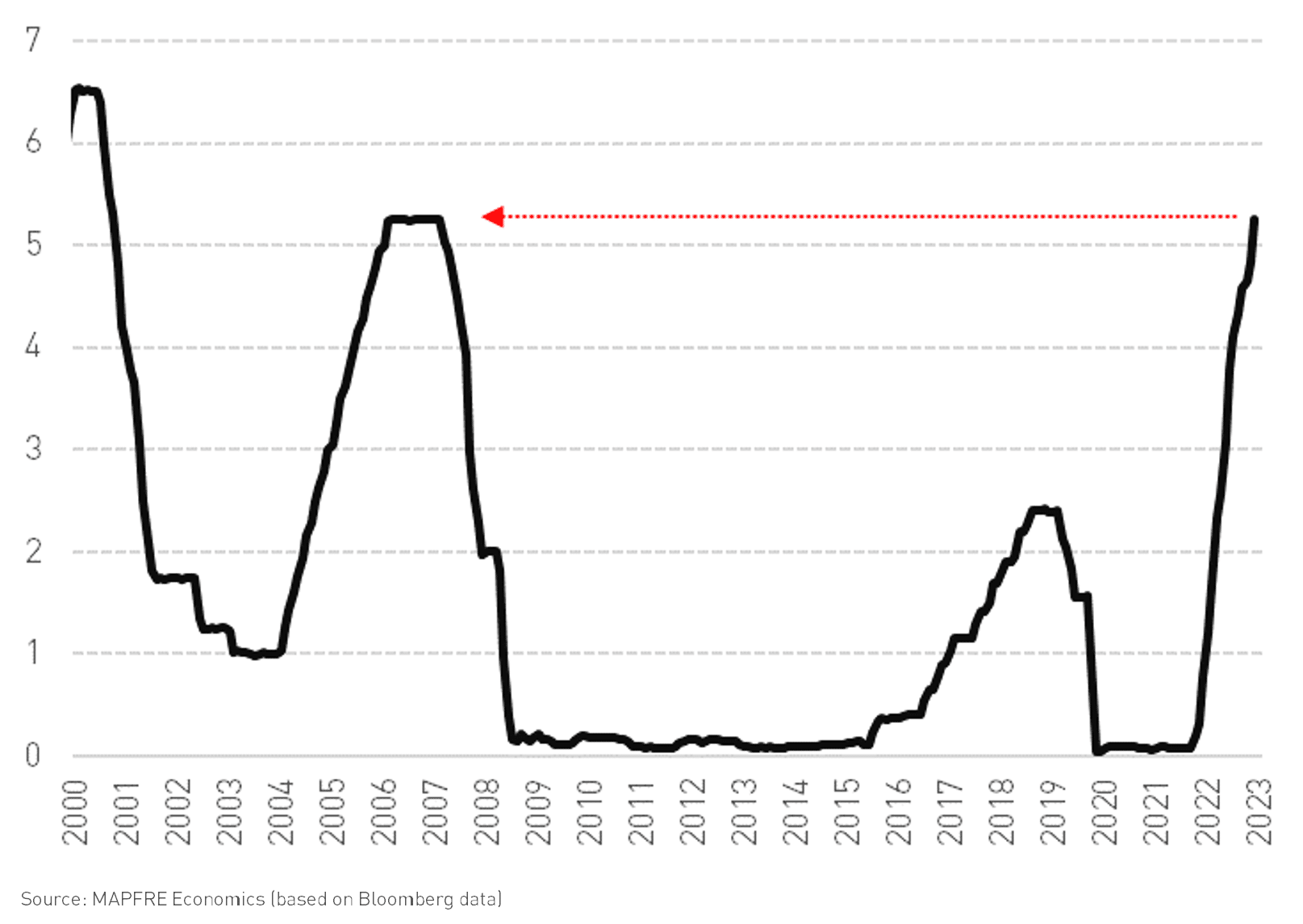
In terms of the balance sheet, the Federal Reserve made no changes to its asset holding reduction, with the monthly combined roll off of $60 billion in Treasury bonds and $35 billion in MBS (Mortgage-Backed Securities), without offering any additional future guidance.
In summary, and despite not presenting new macroeconomic projections or an updated dot plot, the Federal Reserve continued to moderate its message and strike a balance between concerns over price stability and financial stability, offering a conditional pause so as to determine future decisions (based on a new projections table), but ruling out the possibility of an interest rate cut until 2024 at the earliest.
Assessment
The Federal Reserve’s latest monetary policy decision was accompanied by few macroeconomic developments compared to its last meeting in March. In any case, notable highlights included that job growth is still strong (as confirmed by the ADP National Employment Report and payroll data), as is activity data, leading to more positive than expected figures (the latest PMIs indicated that the US manufacturing sector had once again contracted, while the service sector continues to expand, though at a more moderate pace).
As for how this is reflected in prices, the inflation slowdown continues to present a positive reading, although reversal is continuing at a slower than expected pace, with energy acting as the main driver of deflation in the general reading, which is partially canceled out by the rise in food prices and service inflation remaining at high levels. This is not the case, however, in core inflation, which once again logged a year-on-year increase, or in wage growth, which continues to struggle to recover from accumulated loss in real terms (see Chart 2).
Chart 2
General and core inflation
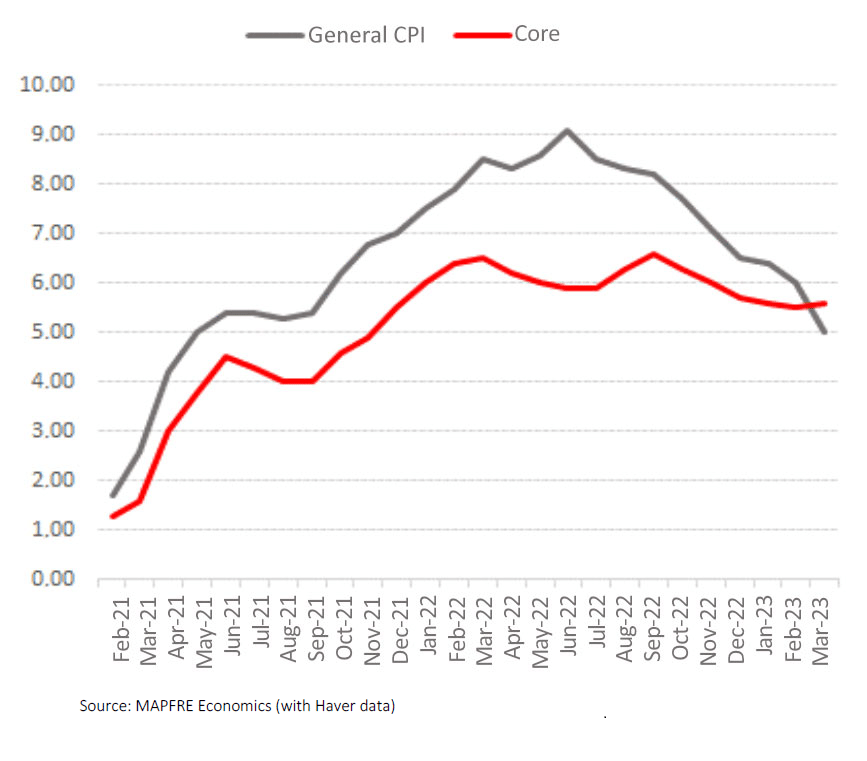
Meanwhile, various instances of financial instability continue to fuel fears over the health of the US’s financial system. A noteworthy event in this regard was the recent collapse of the First Republic Bank, which was subsequently sold to JP Morgan with help from the Federal Deposit Insurance Corporation (FDIC) in the form of a $50 billion credit line. The effects of this collapse have raised the sum of banking failures so far in 2023 above the peak reached in 2008, with $548 billion (in terms of assets of the balance sheet).
At the same time, concerns over the US banking system, far from being quelled, continue to spread to the rest of the regional banking sector, with PacWest Bank leading in a new instance of this spread (see Charts 3 and 4).
Charts 3 and 4
Regional banks and FDIC banking interventions
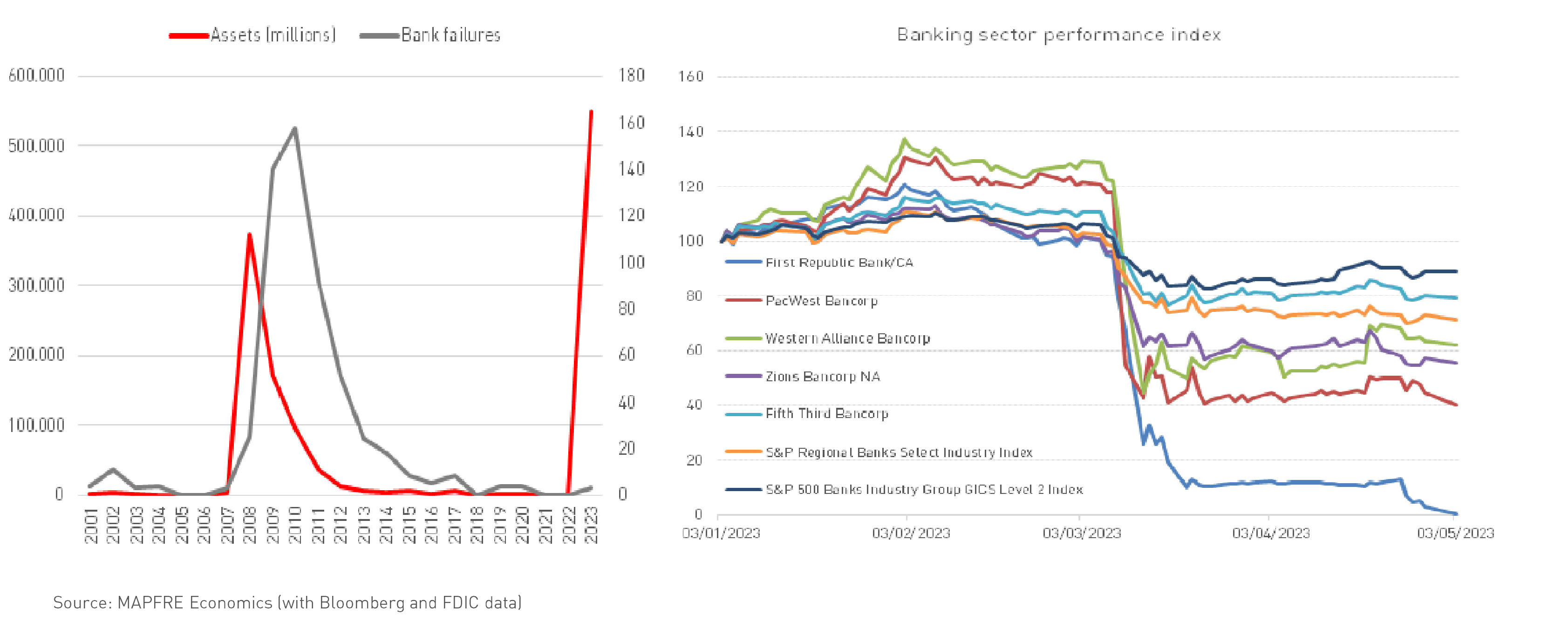
The current disjunction between economic stability (skewed upwards) and financial stability (skewed downwards) are joined, on the one hand, by the cumulative effect of the monetary policy and the delayed effects still to come (the transmission rate of the monetary policy), against a backdrop in which, for the first time since 2019, real interest rates are in on slightly positive ground (see Chart 5), and on the other hand, by uncertainty over the state of credit, as its crunch may suffer an additional setback from the banking sector.
Chart 5
Real interest rates to IPC
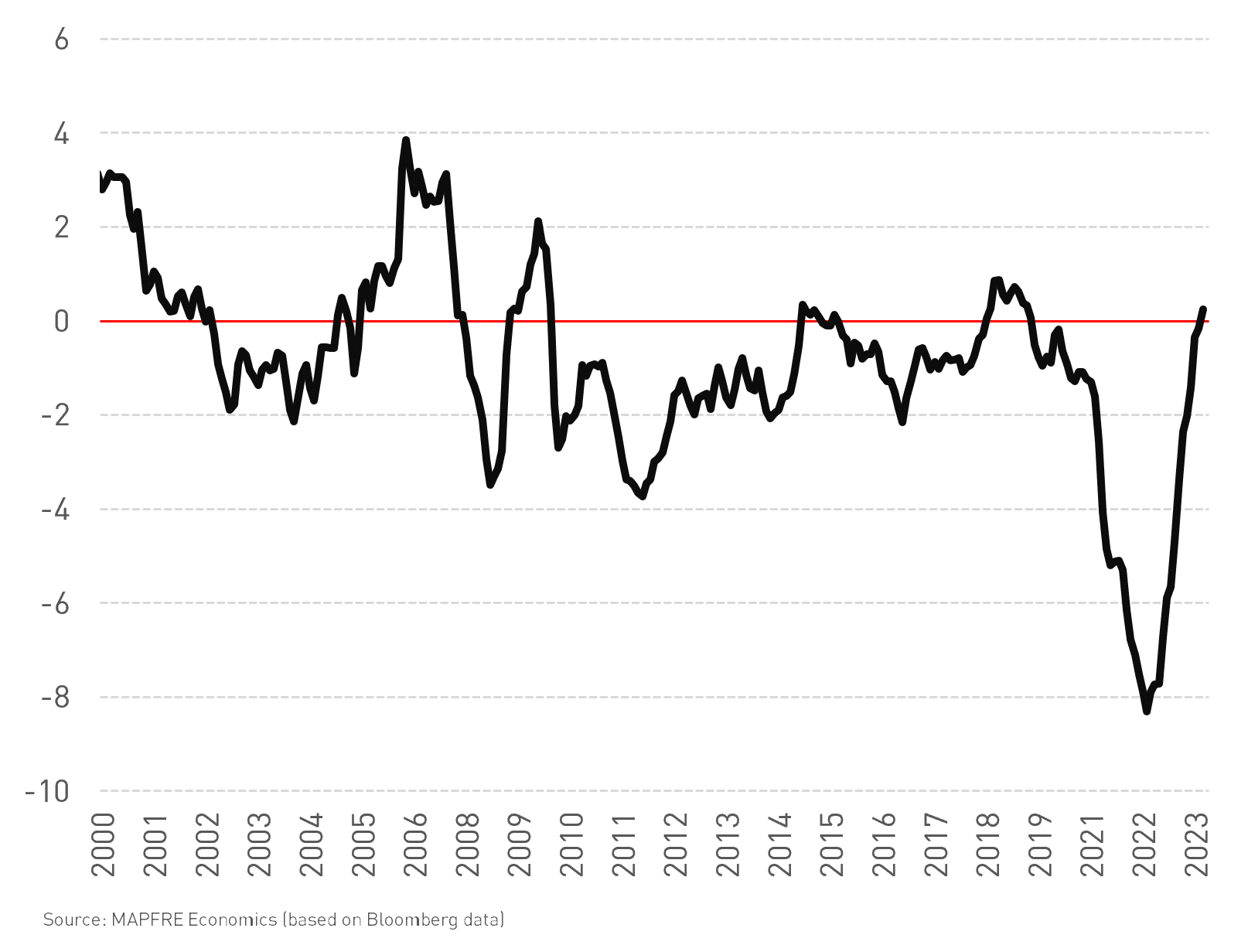
In summary, while the economic situation remains positive (the fact that inflation persists is, in a way, an indication of this strength), for now, the idea that it would be advisable to pause the tightening process is gaining traction. Nevertheless, this seems to be happening through a “proactive” approach, that is, by keeping real interest rate levels positive, and without ruling out the possibility of an additional interest rate hike in response to inflation potentially rising once again (as the risk scenario in our report, 2023 Economic and Industry Outlook: Second Quarter Perspectives, outlines).
However, it is important to point out that this pause in the tightening process is part of a transition path that is already skewed towards giving more importance to the risk to financial stability, as the delayed effect of monetary policy puts pressure on both sides of the balance, and stricter financial conditions slow down demand, and thus, inflation. At the same time, the risk of non-linear events remains high, the catalyst for a lower implicit interest rate at the closing of 2023, in line with market forecasts and persistent signs of recession (see Chart 6).
Chart 6
Yield curve in the United States
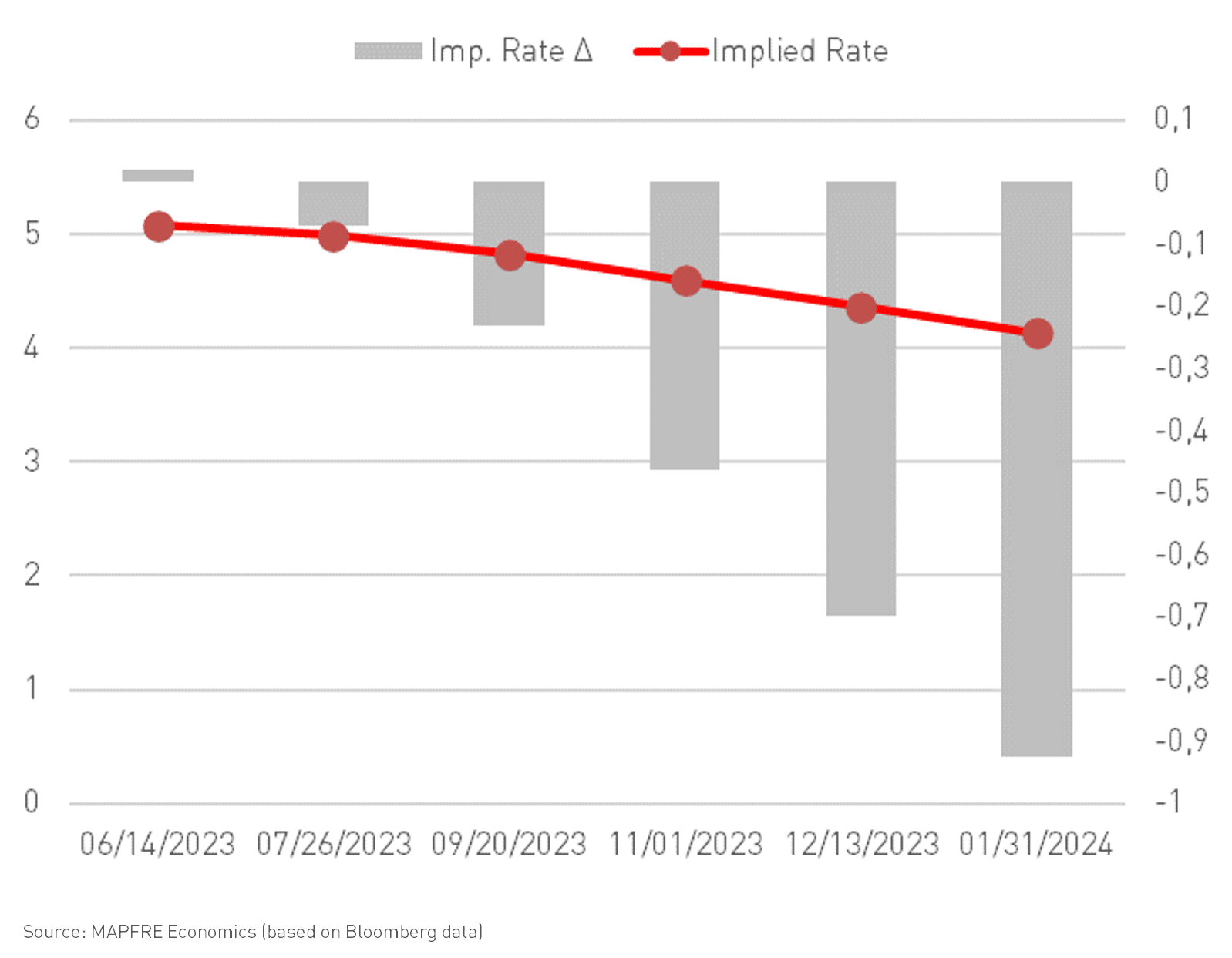
European Central Bank
In a meeting held on May 4, the European Central Bank (ECB) reaffirmed its commitment to monetary normalization by raising benchmark interest rates by 25 additional bps, a smaller increase than those of previous meetings. In doing so, it set the range of interest rates of main refinancing operations and the interest rates on the marginal lending facility and the deposit facility at 3.75%, 4.00%, and 3.25%, respectively.
As for the balance sheet, the ECB is continuing to reduce its security holdings through the Asset Purchase Programme (APP), at an average pace of €15 billion until June 2023, unlike reinvestments under APP, which will be discontinued as of July. Elsewhere, it will maintain its intention to reinvest the principal payments from securities purchased under PEPP (Pandemic Emergency Purchase Programme) until at least the end of 2024, as well as the direction of the Targeted Longer-term Refinancing Operations (TLTROs), with no new developments.
Assessment
As in the case of the United States, economic development that was less punitive than expected has confirmed that perspectives on inflation remain that it has been “too high for too long,” and thus an additional effort in terms of monetary policy is needed.
Despite the steady decline in the general price index over the past few months (the preliminary estimate for April is 7% year-on-year, compared to 6.9% in March, far from double-digit figures), as well as in core inflation (5.6% year- on-year in April, one decimal point less than March and the first decrease since June 2022), the unpredictability demonstrated by the latest Eurostat flash estimates (the year-end trend was curbed and even reversed), inflation figures still far above the 2% target, the effects of the strong fiscal policy shield, very negative real rates, and the gathering momentum of labor market pressures all seem to indicate that the tightening cycle still needs to continue.
Chart 7
General and core inflation
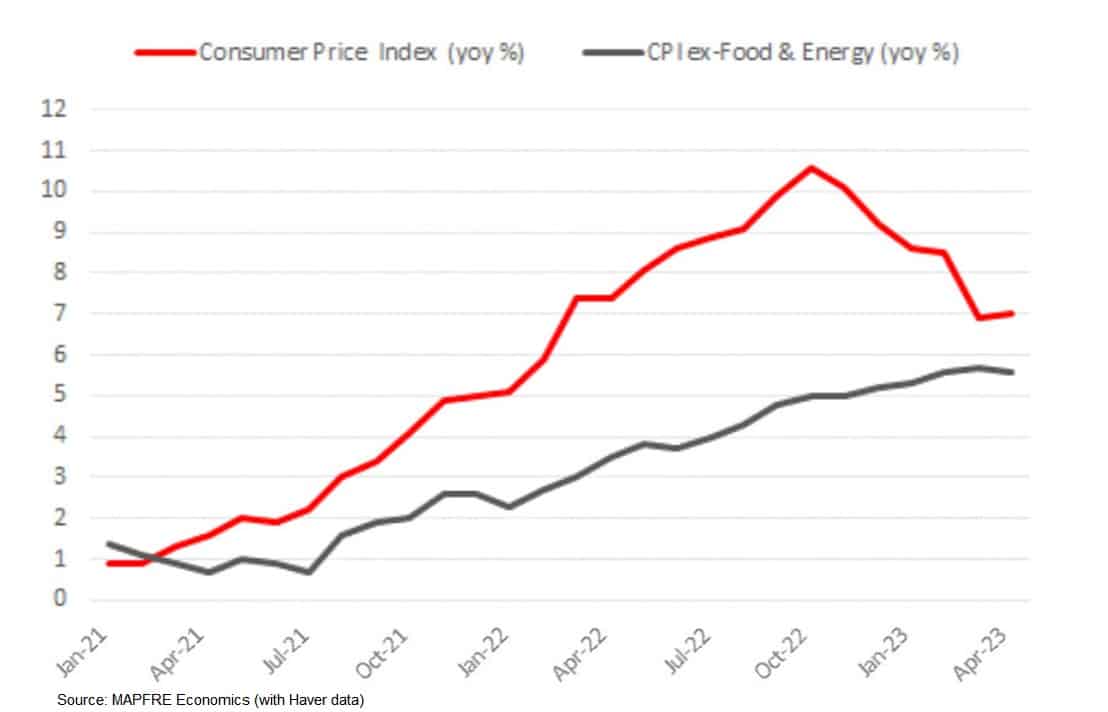
At the same time, as Chart 8 shows, the latest strain on the US banking system, under shared causes (facing heavy unrealized losses due to interest rate risk and certain bank runs to monetary funds in search of risk-free remuneration), was not replicated in the Eurozone, demonstrating that the latter is somewhat resilient, and reinforcing the basis for a strict banking regulation precedent, though it is still incomplete (a banking union still has yet to be finalized).
Chart 8
European banking sector and US banking sector
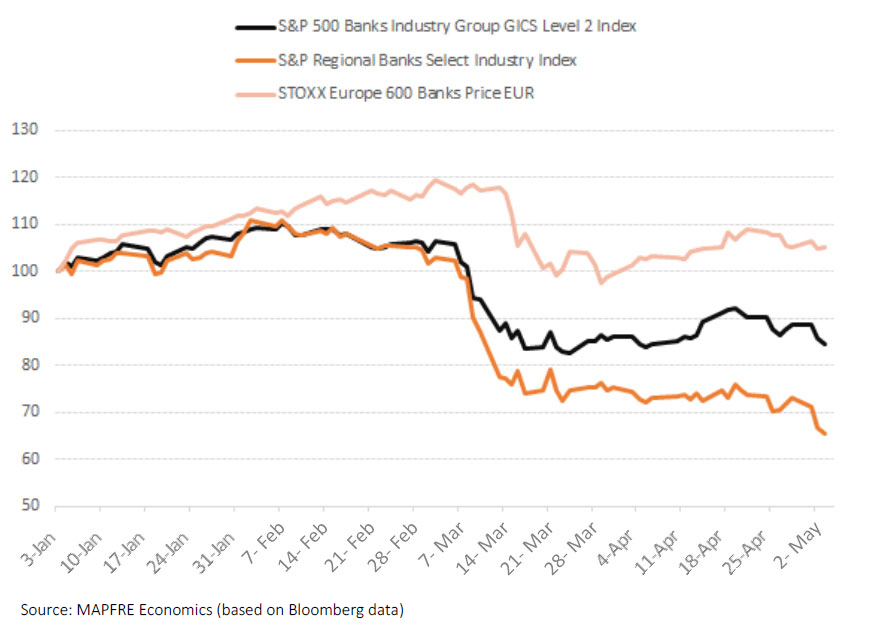
All this, together with the US Federal Reserve’s slight delay in activating the tightening cycle, leads to the expectation that the ECB is still far from reconsidering a pause, based on the combination of price stability (still premature) and financial stability (still unbalanced), and given that the monetary policy transmission protection instrument (TPI) has still not been activated.
Thus, the baseline scenario of the Eurozone’s future monetary stance continues to be maintaining the pace of the interest rate increase at the current 25 bps, at the expense of reducing the balance sheet at a faster rate (see Chart 9). This is considered most likely to happen in the ECB’s next meeting in June, setting September’s meeting up to be the possible turning point for reaching a terminal rate, at which point it will be possible to assess the delayed effects of the monetary policy with enough policy space to sustain positive real interest rates for some time.
Chart 9
European Union yield curves
